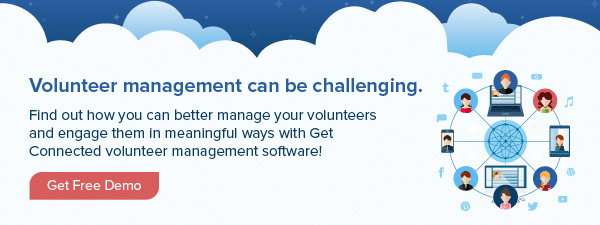Is your organization making the most of its volunteers to address your community’s needs?
Many community-based organizations offer some direct service opportunities, but did you know that your organization can harness the power of volunteers beyond direct service? From philanthropy to activism, there are many ways volunteers can contribute to the common good.
In this article, we explore other community engagement pathways, including:
We’ll also discuss how your organization can achieve greater impact by engaging “indirect” service volunteers.
Community Engagement Pathways
Your organization can appoint volunteers to fill direct and indirect service opportunities. But what is the difference between these community engagement pathways?
Direct Service
First, let’s define direct service:
What is direct service?
Direct services impact clients directly, as volunteers work to address the immediate needs of a community. Volunteers will interact with the community members served, whether they’re tutoring children or beautifying a public park.
Direct service opportunities are great for people of all ages, abilities, and commitment levels.
Keep in mind that direct service opportunities don’t need to be face-to-face. Many organizations employ virtual volunteer opportunities to address community needs.
Regardless of the activity, direct service volunteers are more likely to witness the immediate impact of their efforts, making these types of opportunities appealing to many volunteer programs.
More Ways to Get Involved
While many volunteer programs and their clients rely on the hard work of direct volunteers to elicit change, your organization shouldn’t ignore the importance of other means of community engagement. To tackle complex community issues, engage indirect volunteers, too!
Why should your organization engage volunteers beyond direct service?
Addressing the immediate needs of a community is essential, but addressing a community’s long-term needs requires nonprofits to think beyond direct service. Other forms of community engagement call upon community individuals and groups to influence change on a broader level.
Here are a few benefits to engaging indirect service volunteers:
- Address complex community challenges. Complicated issues, such as environmental, political, or systemic challenges require a sustained, collaborative effort between the public and private sectors, nonprofits and their volunteers, and other constituents.
- Connect on a deeper level. Other public service activities can help you connect with your community and its needs in a truly meaningful way. Your commitment to addressing a cause at its roots alongside your volunteers’ sustained efforts make a powerful force for good.
- Foster lifelong engagement. By offering multiple pathways for meaningful community engagement, volunteers can discover more opportunities that speak to their passions and skills. Volunteers inspired by their work are more likely to become long-term supporters of your cause.
Stanford University Pathways of Public Service and Civic Engagement
What kinds of community engagement opportunities exist beyond direct service?
Below, we reference the Pathways of Public Service and Civic Engagement from the Haas Center at Stanford University. This framework was initially designed for service-learning programs but can be applied by any volunteer program to achieve greater impact.
Policy and Government
Policy and government volunteers help advance the policies and laws that impact communities. Volunteer activities may include:
- Speaking at community meetings
- Raising awareness among constituents and policymakers
- Researching and presenting new solutions and ideas to policymakers
Getting involved at a local level can have a lasting impact on the community. But moving the needle on policy and government can be a long process that requires years of hard work. So, organizations must regularly recognize the contributions of volunteers working to influence policy, governance, and lawmaking.
Social Entrepreneurship and Corporate Social Responsibility
According to the Stanford University model, social entrepreneurship and corporate social responsibility programs “use ethical business approaches to create or expand market-oriented responses to social or environmental problems.”
Corporate social programs typically rely on partnerships between the nonprofit, public, and private sectors. For example, a business wants to give back to the community by donating employee time and a percentage of company earnings to a local shelter. The business will partner with the nonprofit community shelter to appropriately direct volunteers’ efforts and funds.
These partnerships are a key component to reaching solutions to complex community challenges. In fact, you may already be engaging corporate volunteers!
Community Organizing and Activism
Community organizers and activists use their voices and connections to mobilize collective action and raise public awareness on key community issues.
Community organizing and activism activities may include:
- Educating and informing the public on issues
- Coordinating demonstrations, protests, marches, and other public events
- Influence policymakers to reform policies and ordinances
Community organizing often requires a collaborative effort between individuals, policymakers, and community organizations in the nonprofit, public and private sectors.
The collective action of individuals and groups can be especially impactful—the hands and voices of many drive change!
Service-Learning and Research
These opportunities are often used in service-learning settings and educational programs. However, your organization may employ volunteers and students to research a specific cause or challenge so that you can make informed decisions about future programming.
Organizations and campuses can form meaningful partnerships, connecting academic coursework and research with real-world social issues to inspire action.
For example, a service-learning student studying environmental science may team up with an environmental justice organization to gather research and share findings to achieve greater impact.
Philanthropy
Most organizations need money and in-kind donations to advance their mission. Volunteers engaged in the philanthropy pathway may:
- Donate to an organization directly
- Plan fundraising events and campaigns
- Collect donated goods or funds
- Fundraise by reaching out to individual citizens or companies
Nonprofits direct these donations, private funds, or charitable contributions to advance their specific cause.
How to Engage Volunteers Beyond Direct Service
Boost your organization’s impact by recruiting volunteers to serve in various community engagement roles.
Curate Thoughtful Volunteer Opportunities
Indirect service volunteers are working to move the needle on long-standing, complex issues and are less likely to observe the immediate impact of their efforts. That’s why your organization must focus on practices that encourage retention.
One of the best ways to retain long-term volunteers is to curate powerful, focused volunteering experiences.
These tips will help you create impactful volunteer opportunities:
Conduct a Community Needs Assessment
A community needs assessment is a tactical way of analyzing gaps in community services. It also determines the strengths and assets available in that community.
Your findings from a community needs assessment will help direct and inform your programming to maximize impact. By conducting a needs assessment, you can create meaningful opportunities—your volunteers and stakeholders can rest assured your organization is directing its resources in the most impactful and efficient ways.
Learn how to conduct a community needs assessment.
Stay Mission-Focused
Tackling important civic issues is your thing. And it’s tempting to want to address all of your community’s needs.
However, some volunteer programs may not have the depth of resources to stray from their core mission. And that’s okay! Your organization has the resources and expertise in your wheelhouse to create real change.
By stretching your program too thin, you risk losing some of your key players. Your stakeholders, including volunteers, must be backed by enough clarity, support, and resources to affect real change.
It’s important to stay the course, revisit your mission statement, and regularly communicate your mission to volunteers.
That said, sometimes an issue is too important to ignore. In times of great need, volunteer programs and their volunteers are asked to take on challenges outside their typical mission. If you are passionate about tackling a cause outside of your core mission, consider partnerships that make sense.
Match Your Volunteers With the Right Opportunity
The best indirect service volunteers are passionate about the cause and the work you’re asking them to perform. Create meaningful volunteer opportunities for every volunteer.
Learn about your volunteers’ skills and interests during recruitment and registration. This way, you can match volunteers with an opportunity they’re passionate about and suited for.
A robust volunteer management technology can automate the process from vetting and onboarding new recruits to matching volunteers to the opportunities they’ll love.
Form Meaningful Partnerships
Addressing your community’s needs will require a chorus of diverse voices. Whether you’re recruiting for corporate social responsibility or service-learning volunteers, your organization will benefit by leaning on community partners.
Use your connections in the community to source a steady stream of committed supporters and stakeholders. Here are a few ways to form fruitful partnerships:
- Do your research. Look for organizations that already have a presence in your community and who already have volunteer initiatives, like employee volunteerism or service-learning programs.
- Strive for relevance. Seek out partners whose resources, skills, and interests align with your program.
- Reach out to community leaders. From neighborhood associations to houses of worship, your community is chock full of people who want to enact change. Reach out to community leaders, share your mission, and communicate how they can make a difference to your program.
- Discuss values. Once you’ve identified potential partnerships, dig deeper to understand the organization’s culture and values. Remember, your partnership should be a two-way conversation.
Avoid Role Ambiguity
More often, direct service volunteers know what to expect. That is, they arrive at a destination, complete a task, and sign out of their shift. On the other hand, indirect service opportunities tend to be longer-term, and tasks can vary day to day.
Role ambiguity is a common challenge that volunteer leaders face when managing indirect service volunteers. When roles are unclear, volunteers are more likely to disengage.
Volunteers should understand your mission, the purpose of their work, and the responsibilities of the role before committing to your organization.
Here’s how you can avoid volunteer role ambiguity:
Write an Effective Volunteer Opportunity Description
Inspire prospective volunteers by writing irresistible volunteer role descriptions. Include this necessary information when listing and marketing your volunteer opportunities.
- Role Summary – Summarize the purpose or desired outcome of the volunteer position to inspire prospects and acquaint them with the cause before getting into the details.
- Duties and Responsibilities – Include a bulleted list of specific requirements and responsibilities for the role.
- Time Requirements – How many hours are you asking volunteers to contribute per shift/week/month? Include the length of the time commitment, as well as an expected start date.
- Location – Where will volunteers perform the work? Is this an in-person or virtual volunteer opportunity?
- Skill Requirements and Qualifications – You want to ensure you’re getting the right volunteers for the job. But you don’t want to discourage eager supporters from signing up. So, only list required skills and qualifications here. Save additional screening for the volunteer interview later on.
What should you avoid in your volunteer opportunity description?
Avoid outlining every organizational policy and rule (save that for onboarding). While impressive impact statistics certainly have their place in engaging indirect volunteers, the volunteer job description isn’t one of them.
Communicate Your Mission Statement
Think of your mission statement as your volunteers’ guiding star (and your organizations’, too!). Your mission statement will help volunteers understand the purpose and value of their work.
Acquaint and reacquaint volunteers with your mission statement regularly to keep them inspired, even when they can’t see the immediate impact of their work.
Here are a few ways to communicate your mission statement:
- Post your mission statement on your website. Keep your mission statement accessible on your website and volunteer site.
- Discuss your mission during onboarding. Volunteers should understand your organization’s mission from the outset.
- Leverage your e-newsletter. Your email newsletter is a great place to re-inspire stakeholders by highlighting your mission.
- Write a welcome email. When your volunteers register with your organization, send a welcome email and detail your mission statement. Don’t forget to mention how their work will help fulfill your mission.
Learn how to write a compelling mission statement.
Provide Leadership and Mentorship
Your indirect service volunteers assist with complex—and sometimes abstract—community challenges. So, they need consistent leadership and mentorship to maximize their impact.
Try implementing these leadership and mentorship strategies:
Supply Adequate Training
Did you know that volunteer training is associated with higher performance and deeper engagement?
Set your new volunteers up for success with volunteer training. Generally, your training program should:
- Provide a deeper understanding of the organization’s mission and the causes addressed
- Outline role expectations, responsibilities, and tasks
- Establish volunteer objectives
- Acquaint volunteers with tools and procedures they’ll use
- Assess any knowledge and skills gaps, then work to fill these gaps
- Create a framework for further evaluation
You may need to provide additional training for volunteers fulfilling skilled or specialty positions. You will also want to provide regular refresher courses to keep volunteers up to speed and engaged.
Invest In Volunteers’ Development
These engagement pathways can yield especially effective results for a community. And these types of opportunities can also lead to profound experiences for the volunteer.
While you can’t pay your volunteers for all their hard work, you can invest in your volunteers’ personal growth. Offer career development, skills development, and networking opportunities to enrich the volunteer experience and deeper engagement.
Invest in your volunteers in these ways:
- Leadership opportunities. By allowing volunteers to help shape the direction of your program, they become more invested in its outcomes.
- Community ambassadors. Volunteers are representatives of your organization and your community. So, send them to site visits, fairs, and anywhere else you want to promote your organization. Volunteers are exceptionally skilled in recruiting other volunteers, and they’ll appreciate the opportunity to help advance your cause.
- Career training. Encourage volunteers to practice their skills and boost their resumes. Pair a student with an opportunity that supports their studies. Or ask professional or retired volunteers to demonstrate their expertise. Skilled individuals can offer fellow volunteers and community members a great deal of knowledge, insight, and advice.
- Feedback and recommendations. Take the time to help your volunteers grow in their roles and beyond. Offer letters of recommendation and feedback to help volunteers fulfill academic requirements or boost their careers.
- Invest in better tools. One of the best ways to support your volunteers is to invest in tools to improve their experience. By investing in time-saving management tools, for example, you’ll also be able to spend more time forging meaningful connections with your volunteers, all while boosting retention.
Pair Volunteers with Mentors
One of the best ways to support indirect volunteers is by providing them with a volunteer mentorship program. The volunteer mentor may be a member of staff or a seasoned volunteer. Mentors can guide recruits, assist in training, and serve as point people if the volunteer needs on-the-job guidance.
Track and Report Progress
Indirect volunteers are less likely to experience the positive feelings associated with observing the immediate impact of their efforts. That’s why it’s important to set measurable goals and communicate progress—you’ll keep your indirect volunteers motivated and inspire your community.
Set Measurable, Incremental Goals
Moving the needle on important community issues can take years of hard work. That’s why volunteers participating in opportunities beyond direct service are more likely to become disengaged.
You probably have long-term goals, but are you measuring and celebrating even small successes?
Here are some examples of measurable goals:
- Number of volunteer hours to serve on a project
- Number of citizens to contact
- Dollars to raise during an event
- Event attendees
Track volunteer contributions easily using an automated volunteer management system.
Celebrate Milestones
Celebrate milestones, incremental progress, and small wins. Recognize the volunteer who landed an interview with a governing official. Celebrate the group that canvassed the neighborhood. Acknowledge the student whose research proved valuable to understanding your community. Or, simply honor the dedicated volunteer who puts in time each week.
Gather Stories
Your volunteers aren’t working personally with clients, so they may miss out on those powerful moments of seeing their work positively impact others.
Help your volunteers understand their impact by interviewing clients, community members, and stakeholders. Ask interviewees to share how they have been personally affected by the work of your program. These stories can be profoundly motivational.
Don’t forget to share the qualitative and quantitative progress and outcomes of your volunteer program by sharing your impact.
Manage Volunteers Effectively
Managing indirect service volunteers can be tricky. You have volunteers working in different locations on a variety of tasks while collaborating with numerous stakeholders. So, it’s important to have a system in place to efficiently manage your direct and indirect service volunteers.
Your Volunteer Program Hero: Volunteer Management Software
Enter volunteer management software. Volunteer management software helps volunteer leaders save time on administrative tasks, mobilize volunteers, and access important data to support and grow their mission.
Learn more about the best volunteer management software for your program.








